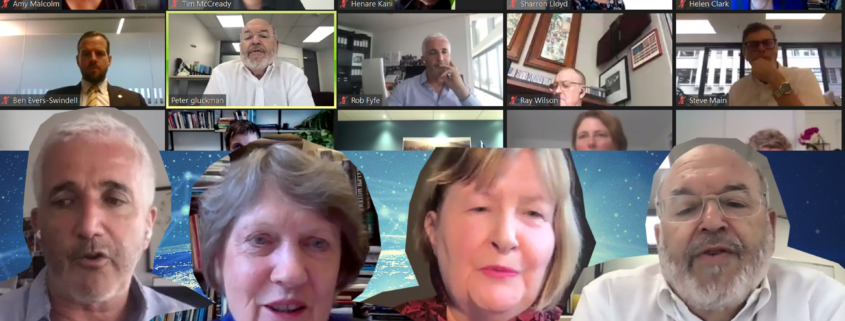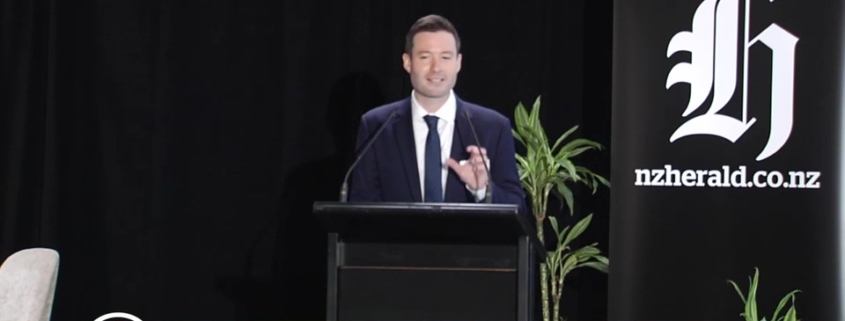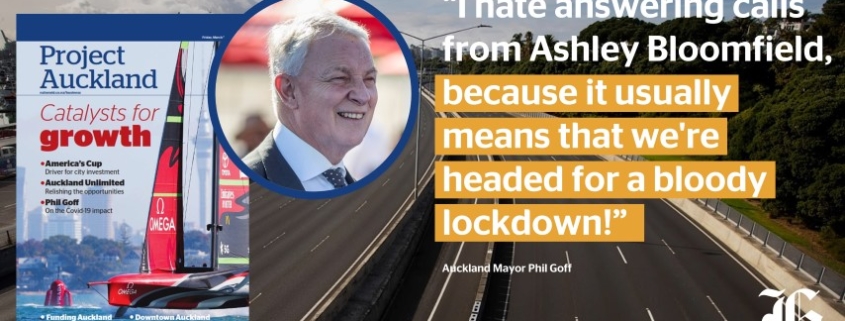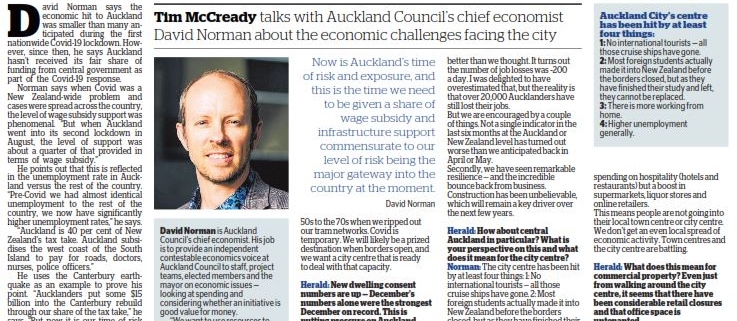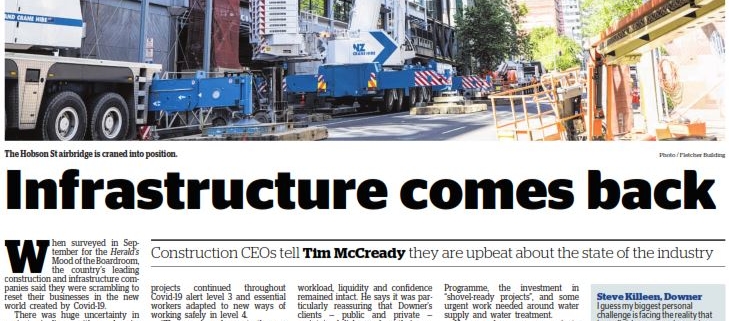Project Auckland: Construction bosses upbeat about the state of the industry (NZ Herald)
When surveyed in September for the Herald’s Mood of the Boardroom, the country’s leading construction and infrastructure companies said they were scrambling to reset their businesses in the new world created by Covid-19.
There was huge uncertainty in project pipelines, with works significantly down due to the cancellation of jobs. CEOs told the Herald that the priority over the next six months would be to ensure specialist skills could be secured despite the border restriction constraints, and re-setting a “forward cost base within an uncertain demand profile”.
Six months on, CEOs are upbeat about the state of the industry, noting it has recovered well following the initial lockdown last March.
This is critical to Auckland’s future where the lion’s share of the infrastructure and construction build is taking place.
Peter Reidy, Fletcher Construction chief executive and co-chair of the Construction Sector Accord says it is was pleasing to see how well the industry adapted to Covid-19 protocols, noting that Fletcher’s biggest projects continued throughout Covid-19 alert level 3 and essential workers adapted to new ways of working safely in level 4.
“That speaks volumes to the emphasis we are all putting on safety in the workplace,” he says. But he raises concerns with local council infrastructure investment, with pressure on rates and a decline in developer contributions and local council investment returns pointing to big gaps in infrastructure capital investment to meet expected demand.
Reidy says it is pleasing to see that the Minister of Finance, Grant Robertson, is now also the Infrastructure Minister: “We look forward to continued investment to plug New Zealand’s considerable infrastructure deficit,” he says.
Downer chief executive Steve Killeen says the remarkable recovery from what could have been an 80s-style recession speaks to the resilience of the sector and the actions taken by the Government to ensure workload, liquidity and confidence remained intact. He says it was particularly reassuring that Downer’s clients — public and private — maintained dialogue about their project intentions and opted for simple, effective procurement mechanisms.
“I’m pleased to say the commercial building market recovered quicker than expected and we have now secured wins in education, health and defence that will see our revenues recover in the FY22 financial year.” However, he notes that the past year of uncertainty has reinforced the tendency of the sector and its client base to think short term, slowing down the focus and investment needed to resolve intergenerational issues that stand to negatively impact both the sector and the quality of life in the communities it serves.
Beca CEO Greg Lowe says that large infrastructure projects have started to build up momentum again following the Government’s commitment to the New Zealand Upgrade Programme, the investment in “shovel-ready projects”, and some urgent work needed around water supply and water treatment.
However, he says many private sector projects — particularly the vertical construction market (construction of high rise commercial and residential buildings, as compared to horizontal construction which relates to infrastructure and related construction) — have slowed right down.
“This is an area where small contractors and tradespeople are employed,” says Lowe. “However, more hospital and university projects are helping to fill this gap, and vertical projects driven by local councils are also helping to keep contract work and employment up.”
Fulton Hogan managing director Cos Bruyn says though he is seeing signs of improvement in the private sector now, it will still be some time before activity matches the level that existed pre-Covid. He says that short-term the workload is a good, but describes the medium- to long-term outlook as “murky”.
He puts this down to the challenges of getting work consented being as problematic as ever, the legislative reform being considered by the Government including RMA, and the implementation of National Environmental Standard for Freshwater 2020 — which he says is a big issue for the Auckland region and has the potential to sterilise new residential and commercial development land and quarry reserves.
The industry’s leading chief executives were asked about the biggest challenges they are now facing:
Peter Reidy, Fletcher Construction
The technical skills capacity shortage, particularly in core, frontline project delivery roles is a major challenge.
We are starting to see the real impact of border closures on labour and skilled technical capability. There is competition for these skills domestically and labour costs are increasing in the infrastructure and commercial construction sector.
There is a lot of time and effort going into apprenticeship and graduate programmes in the industry, which is great to see, but you just can’t train in a short space of time for roles which require very specialist skills or international experience.
As an industry we need a much greater focus on inclusion and diversity in our workforce. The number of women attracted to and entering construction is still far too low and we have to do something about that. It’s great to see a real focus on apprenticeships and graduates and what we can do there but ensuring our workplaces are genuinely inclusive for everyone — culture, gender, age and sexuality — is still a priority.
Plenty of challenges today.
The challenge for tomorrow is attracting the new skills needed for the future of the industry, including a more digitally-enabled construction eco-system.
Steve Killeen, Downer
I guess my biggest personal challenge is facing the reality that I may finish my career in a sector that is no better, and in some cases worse, than when I started in the 80s. A sector typified by a lack of sufficient skilled resource, failure to adopt technology, mixed quality and efficiency and very alpha male in the way it goes about business.
I’m still committed to making a difference and have given a lot of thought to the root cause of the sector’s challenges – I believe there are three nuts we need to crack:
• How do we provide confidence in the pipeline of work and ultimately level the workload?
• How do we get the best creative, technical and practical minds around our immediate and future social and economic infrastructure needs?
• How do we focus on long term cost-efficiency rather than price?
Covid and the restrictions it imposes could well be described as the greatest current challenge to the construction industry. However, it is my view that it purely magnifies immediate issues and reduces our focus on the long-term challenges in the sector.
Cos Bruyn, Fulton Hogan
Availability of skilled labour is of growing concern and this is being felt now in the Auckland market. This is a big issue in Australia presently with high demand in a number of states given the strong infrastructure build materialising now. NZ will be targeted as a labour resource pool adding to the challenge.
There is a distinct lack of major project work in the South Island and this will have long term ramifications in retaining resources and key skills.
Overall, the sector along with the rest of NZ will have to contend with the ongoing uncertainty the Covid response brings; recent decisions to lock down have been made with little notice and reduce our ability to plan or mitigate the impacts. This is impacting on the mental wellbeing of our staff and all New Zealanders.
We are also starting to see significant cost increases in imported materials and availability. We have yet to see the worst of this.
Bitumen is a high-volume and high-cost input in the roading sector. Production of domestic bitumen at the Marsden Point Refinery has closed, so the NZ market is 100 per cent reliant on imported bitumen. This may lead to supply chain resilience issues and cost increases.
Greg Lowe, Beca
Predicting start times for design work on large projects is an ongoing challenge. Across many sectors there is a long delay from being advised of bidding success, to then getting contracts in place and work starting. This can leave people intended for projects sitting “on the bench” for longer than needed.
With low unemployment and a need to bring more resources into the sector to ensure projects get to construction as early as possible, staff capability growth is key. We focus heavily on graduate recruitment, staff development and attracting Kiwis back to New Zealand, but longer term this won’t be enough. We will need more skilled labour from offshore to augment staff development here.
Border restrictions are still a challenge with high demand on managed isolation and quarantine. We have three main challenges — getting overseas Kiwis we have recruited a confirmed place in MIQ, getting critical workers needed for projects who are not Kiwis through MIQ, and getting a plan in place for our people who are needed on site on our overseas projects.
Overseas sites have considerable restrictions in place and it’s tough work, meaning people want to know they can get home for a break. This is important because this is export services revenue for NZ — we do work here on overseasprojects, then need to send Kiwis overseas to the site for implementation. This generates export revenue, which is currently on hold. We need a way to book people into MIQ say six months out so our staff have the confidence to go on overseas assignments.

